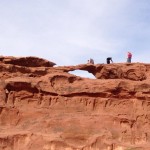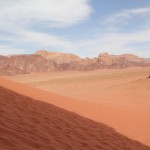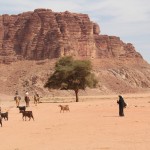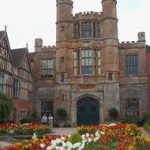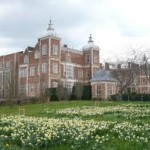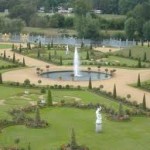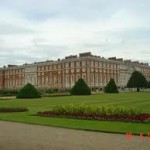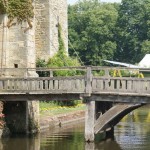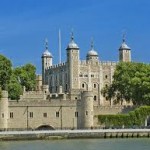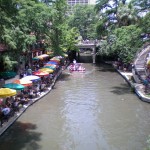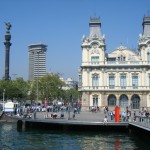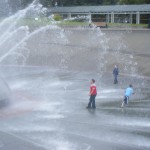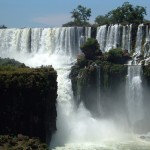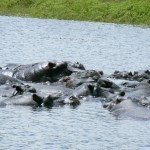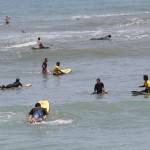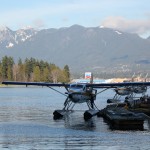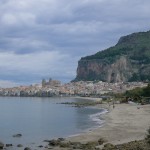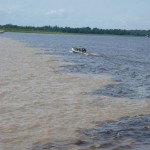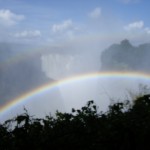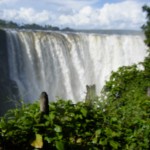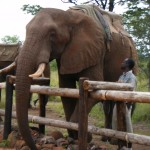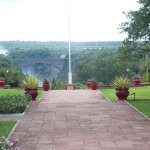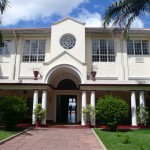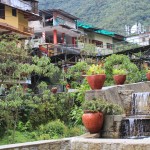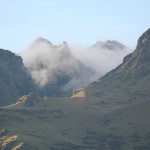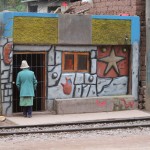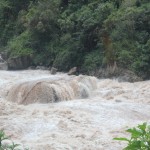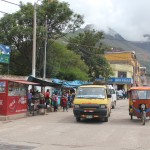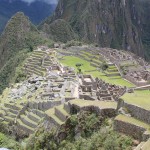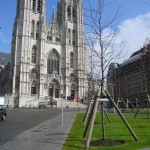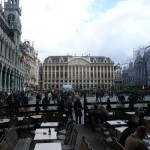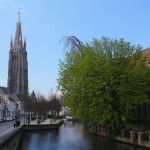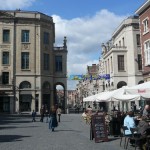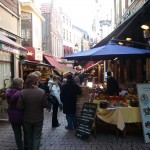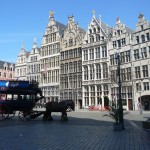Archive for the ‘Destinations’ Category
I’ve been back from the Middle East for close to four weeks now. Yet at least a few times a week, as I’m walking around the city, I swear I hear the Islamic call to prayer somewhere in the distant background. It’s more likely music playing a ways off that I can’t distinguish, or something of the like. But it catches me, and just for a second I pause and strain to hear.
For those who don’t know, I live in Philadelphia. If we have more than one mosque here, it’s a lot (I do believe I’ve seen one). We’re a relatively diverse city, we just don’t have a lot of mosques. So I’m quite sure that the noise I’m hearing is not actually the call to prayer. Especially because I’d never heard it before going on my trip. But while I was in the Middle East, I was absolutely awed by the call. At first, I was intrigued. As I mentioned, I’d never heard it. Now I’ll be fully honest – as a newbie to the region, I kind of pictured everyone stopping in their tracks and praying five times a day. Pardon the ignorance on that one. It had never been to the Middle East and the only people I’d known that had been hadn’t been very recently.
I hadn’t made it out of the Dubai airport when I heard the first call to prayer. It was the later evening one, the last of the night. It was faint, tough to hear over all the clanging of the luggage and voices of excited tourists, but it was beautiful.
In Dubai, I had to actively listen to hear the call, and even then it was difficult. The area in which we stayed was the newer section, filled with construction in lieu of mosques. I didn’t plan it that way; it was the pre-assigned conference hotel. I was disappointed. The bit I’d heard in the airport had piqued my interest to learn more not only about the call itself, but the whole prayer process.
In Jordan, I got to hear the call a little more, but not much. We were out in the deserts much of the time, so once again not in good hearing distance of the minarets. I did learn a bit more, though. I learned that the call is five times a day. It is based on sunrise and sunset, so it can change throughout the year. I also learned that Muslims do not actually have to stop everything they are doing, grab a prayer rug, and pray the minute that they hear the call. Our guide told us that he can “save” his prayers if he’s in the middle of guiding, and pray more when he gets home. Further more, he does not have to pray in a mosque, or any place specific. He can pray where he chooses, as long as he does pray. (For the record, I’m using “he” here because our guide was a man, but the same goes for women). I learned that there are actually two “calls” with each call – one to let people know it’s time to pray, to give them time to wash and get to a mosque if they choose, and the second, about 10 to 15 minutes later, to start the actual prayer. In addition, the imams no longer have to climb up to the top of the minaret. They now stand at the bottom with a microphone, and it’s projected over the city from speakers at the top. I guess even this age-old tradition has had to adjust to the times a bit. It doesn’t matter though, at least not to me.
As our trip progressed, I continued to listen for the call, and each time I heard it, I grew enthralled. By the time we made it to Istanbul, where mosques and minarets are almost literally on every corner, I was completely enchanted. I couldn’t understand how people could not stop in their tracks when they heard it. I don’t even pray and it made me wish that I did. It is such a hauntingly beautiful sound.
Back home, as I walk around the busy streets of Philly, I hear traffic, conversation, dogs barking, and even occasionally church bells ringing – which I’ll admit I also think are worth stopping to listen to. But nothing like the call to prayer. Nothing that makes a non-pray-er want to drop to their knees and pray to something, even if they don’t know what. This has nothing to do with religion for me. If you care to know, I’m an aspiring buddhist, and my form of prayer, if you’d like to call it that, is meditation. It has to do with simply the sound and mystique of the call for me. Perhaps if I heard it five times a day, every day, for my entire life, I’d be able to walk on without even noticing it like so many people in the Middle East seemed to be able to do. I guess I probably won’t ever find out unless my life suddenly, somehow, takes me abroad for an extended period of time. So for now, I hold the call to prayer in a special place, a place of reflection, awe, and respect for the fact that it can impact a person so profoundly.
If you’ve never heard the call, here’s a recording on my Chimera Travel Facebook page.
Disclaimer: The details I’ve stated about the prayer process were those related to me by our guides throughout the trip. If any are off a bit, I sincerely apologize. I did my best to relate what they told me in the most factual manner when it came to the aspects of the religious process.
Posted in
Destinations by
chimeratravel on May 1, 2013
A couple of weeks ago I took a trip to Dubai, Jordan, and Istanbul. Jordan was, hands down, my favorite. It’s a magical place with magical people and I simply fell in love with it. In our somewhat whirlwind trip, we visited Wadi Rum, Petra, Jerash, and the Dead Sea, and all were spectacular. Learning about the history of the Nabateans at Petra and walking the same streets as the Romans in Jerash was awe-inspiring. Not to mention the hysterical laughter that ensued with the dead sea mud bath. But my favorite experience was a non-touristy one, one on which I hadn’t planned on, that I can’t say most other people traveling to Jordan have had.
Most tours in Wadi Rum stop at a bedouin tent. Usually, though, it’s a tourist tent. It’s set out for visitors to come and see the bedouin lifestyle and experience a little bit of the culture. While interesting, it’s somewhat standard. Ours was different. Our bedouin guide, Mousalam, took us to the home (tent) of his aunt and uncle. It certainly wasn’t a “canned” stop. They had migrated recently, and he couldn’t even find the tent at first so we had to drive around for a few minutes. There were no trinkets for sale, no other cars parked out front. We were instructed not to take photos of any kind – the women particularly do not like having that kind of attention.
We wandered into the tent, probably about 6 x 8 feet total. It was the “men’s side.” When there is company (or at least bedouin company) the men and women do not sit together. They made an exception for us, but they did not come in. Mousalam’s aunt was in the women’s tent brewing tea, and he acted as the go between, getting the tea from her and asking her a couple of basic questions that we had about the tent and general bedouin living (for instance, we learned that our “men’s tent” slept about six to eight people). The tea was delicious, piping hot, and very sweet. As we talked to Mousalam about their lifestyle, he told us about his daughter was currently staying with the aunt and uncle here. We hadn’t seen her yet, but as two camels that did not belong to the family wandered up, she ran out – from the women’s tent I’m assuming – and shoed them away.
We did tip them a slight amount. While it wasn’t expected, we had come to their home and drank their tea, and we felt it appropriate. But it wasn’t part of the plan. They didn’t bring us there for the money or to purchase anything (indeed, there was nothing to purchase), but to immerse into the true bedouin lifestyle, and through his family no less. I can now say that I have had tea in an authentic bedouin tent in the middle of Wadi Rum. That’s pretty cool.
I obviously do not have any pictures to share, but I’ve added a few pictures of Wadi Rum itself below. I hope you find it as breathtaking as I did.
Posted in
Destinations by
chimeratravel on March 4, 2013
Today feels like a good day for some trivia fun. And some travel photos. How well do you know you’re international destinations? Take a look at these photos and clues, and see how you score!
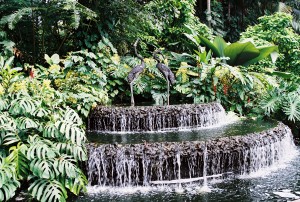
1. This country’s National Orchid Garden is the largest orchid garden in the world.
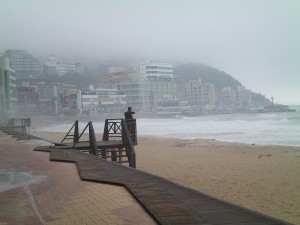
2. This city’s seaport port is the fifth busiest in the world.

3. This country’s Karst region is filled with over 8,000 sinkholes, and visitors can take guided train and walking tours through it’s limestone caves.
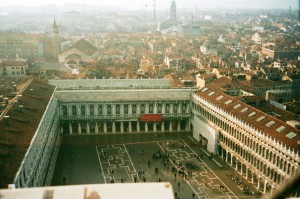
4. In the late fall and winter months, this country has flooded so much that people have actually gone swimming in the square above.
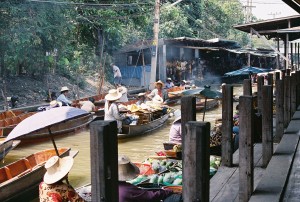
5. The floating market near this city gained fame in a James Bond movie.
Posted in
Europe by
chimeratravel on January 14, 2013
Normally my blogs don’t focus around specific products or tours. However, I’m making an exception today, because this isn’t an external product, but an exclusive offer for Chimera Travel’s clients. I am very excited to announce that in September 2013, we will be leading our first ever small group Tudor Hisotry Tour through England in conjunction with the company Tudor History Tours on the ground in England. The tour will run September 18 – 26, 2013, and has been created exclusively for our group.
The itinerary includes:
Buckden Towers: Once home to Catherine of Aragon
Peterborough Castle: Catherine of Aragon is burried at Peterborough, as was Mary Queen of Scots until her body was exhumed and re-inturned at Westminster Abby.
Kenilworth Castle: Queen Elizabether I and Robert Dudley stayed at Kenilworth on Summer Progress
Coughton Court: Coughton was in the influential Thockmorton family for many years. Today the site contains Tudor artifacts, including the chamise that Mary Queen of Scots is said to have been exectued in.
Sudeley Castle: Family home of Katherine Parr, who burried in a church on the grounds
The Vyne: Of great importance to Henry VIIII, today The Vyne contains relics and stained class windows hear portray Catherine of Aragon and Henry VIII
Windsor: The castle here is the oldest occupied caslte in the world, and home to the current Queen
Hamtpon Court Palace: The only palace built by Henry VIII that is still standing, Hampton Court is steeped in Tudor history.
Hever Castle: Childhood home of Anne Boleyn
Pennhurst Place: Given to Anne of Cleves as part of her divorce settlement from Henry VIII
Hatfield House: Childhood home of Mary, Elizabeth, and Edward Tudor
Tower of London: Served as both a royal estate and the notorious exectution site of Anne Boleyn, Katherine Howard, and Lady Jane Grey
We are also working on possible visits to Syon House, the Globe Theatre, and Kimbolton Place – where Catherine of Aragon was forcibly taken and later died. Kimbolton is closed to the public, but Chimera Travel may be granted private access.
Space on this trip is truly limited, as we are looking to take just a small group. If you are interested or have any questions, please email me for furter details. You are welcome to pass this information on to others who may be interested!
Posted in
Destinations by
chimeratravel on December 13, 2012
I love to travel over the holidays, particularly New Years. It’s so intriguing to see how other cultures celebrate the end of one year and the beginning of the next. With only a couple of weeks left in 2012, I thought I’d share some photos from a few of my favorite holiday trips. I’d love to see yours!
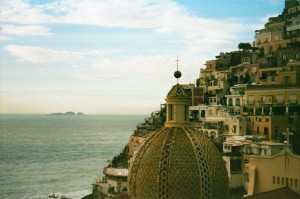
Positano, Italy. They celebrate New Years Eve with music and dancing on the beach, and a local parade through the windy streets on New Year's Day.
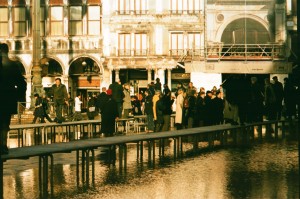
Venice may well ring in the New Year aquatic style. The island can flood badly in the late fall and winter months.
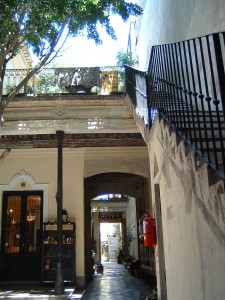
In Buenos Aires, they rip of the calendar from the current year and throw the shreds out in the street putting the past behind them.
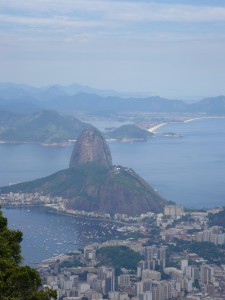
In Rio and other cities in Brazil, they love to party. If you want an all-night bash, Brazil's a great place to ring in the New Year.
Peru is absolutely packed with amazing towns, cities, sites, history, culture, food, and truly interesting people. There are probably innumerable “must sees” in the country. Most of them are rather obvious – Machu Picchu, the rain forest, Cusco, for example. One town, though, that you probably won’t find on any tourist map is Pucusana. You need to go. It’s that simple.
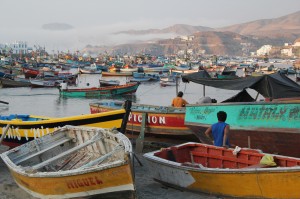
Pucusana is a fishing village, about 45 minutes outside of Lima. We went on a private tour with Pax on Board, a Lima-based tour company that specializes in unique tours that you won’t necessarily find with your standard tour company. Our guide, Nilton, was absolutely phenomenal, and his passion about his country made the tour that much interesting – when the person taking you around for the day exudes passion for the places that he/she is showing you, the day elevates from a tour to an experience.
The first stop in Pucusana was a blow hole, quite a treat and not something we’d seen anywhere else during our time in Peru. Watching local kids wade and play in the water, running away every time the blow hole “erupted”, offered up an image of what life on a Saturday afternoon in Pucusana is like for these residents.
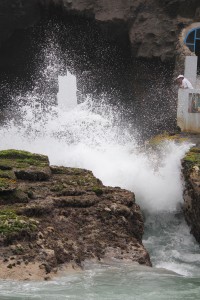
We then headed over to the fishing boats, where we boarded a very legitimately local boat with a very legitimately local fisherman. There was no question that this man fished for his livelihood. This wasn’t some touristy excursion, this was a couple of hours on an authentic Pucusana fishing boat. First off, the color and culture in the town is a photographer’s dream. Watching the boats wander out into the water, the fisherman bringing their catch back to the active fish market, the families and dogs (yes dogs!) working aboard the boats. It’s an ideal place to catch a cultural “action shot”.
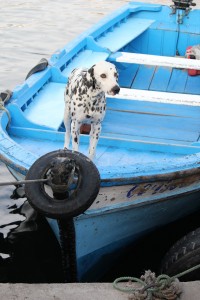
Once we got out of the harbor area, we started to experience wildlife viewing more prolific than we’d seen even in the rainforest. Who knew this little fishing town was full of seals. Or penguins! Our boat “captain” stopped to feed some pelicans (cranes? I might not have the name correct), and they were so close I thought they may somehow manage to get into the boat. We saw endemic birds that we hadn’t spotted anyone else on our trip. It was truly an incredible example of the ecological scope that the country offered, right here in this small fishing town.
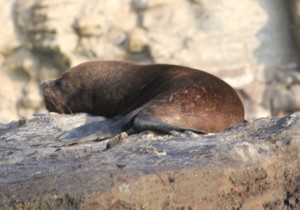
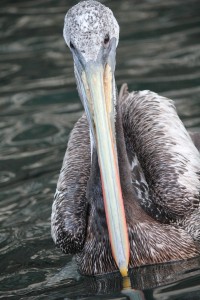
I can’t recommend this tour enough. To add to it, we also got a private tour of parts of Lima that traditional city tours don’t go to, where we say “real” Lima life, not just the downtown areas, also by Pax on Board, and highly recommended as well. I also can’t thank Nilton and his company enough, and I need to mention Donovan at Ideal South America, who connected us with Pax on Board in the first place. I would be 100 percent confident sending my Peru-bound clients on this tour, and hope to do so in the near future. Thank you, gentlemen, for a wonderful experience!
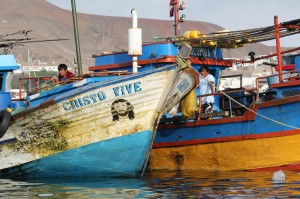
PS Let me make it very clear, I reached out to both Nilton and Donovan to ask if I could write this blog and mention them. They in no way hired or even requested that I write this. I just had to share my one-of-a-kind experience with my readers, and I couldn’t do so without mentioning those that made it that possible.
Posted in
Destinations by
chimeratravel on August 12, 2012
I’m a person that needs to be near the water. There’s something that draws me to it that I can’t explain. I love lakes, waterfront promenades, boats, even fountains. Travel gives me a wonderful opportunity to explore and photograph water in many forms. Here are some of my favorite water photos, whichI feel capture the feeling of the destinations.
Posted in
Africa,
Destinations by
chimeratravel on August 6, 2012
Ok, I’ll admit it, I cheated a bit on this one as well. It was really the whole area that amazed me. The town itself wasn’t spectacular, but the whole experience was. Victoria Falls is the final (at least for now) in my surprising cities series.
Why I went: As part of a trip to Southern Africa. We wanted to see Victoria Falls and decided to go from the Zimbabwe side. It wasn’t in the orignal itinerary, but we added it in before we went.
What I expected: To be amazed by the falls and to enjoy the elephant back safari, but pretty much nothing else. I’ll admit some apprehension. There were travel warnings, and the week before I went the former Prime Minister’s wife was killed in a car accident, in which he was also injured. This was a bit of a scandal at the time, and didn’t help with the warnings to stay clear of the country.
What I found: A people who were so friendly and welcoming that it was hard to believe anyone could be that nice in the face of so much poverty that they can no longer accept their own currency; a country filled with landscape, adventure, wildlife, and a culture they manage to maintain despite such hardship; a sadness that underlies this culture when they tell you that it?s ok if you tip them in old shoes instead of money, because they?d be so thrilled to be able to put shoes on their family?s feet; the framework for a country that could be even more incredible given the opportunity, and that already offers an amazing experience for those tourists who are willing to give it a chance.
How long to spend there: You can easily spend three nights here. Depending on where you’re heading in from, it can be a bit of a journey so take the rest of the first day/evening to relax. I can’t recommend enough that you stay at the historic Victoria Falls hotel. You can actually see and hear the falls from the back dining patio. You could spend part of a day just exploring the hotel and its grounds. In addition to the falls, activities available in the area an elephant back safaris (highly recommended), Lion walks, game drives – both day and night options, river safaris, white water rafting – considered some of the best rapids in the world, and more . Given all of these options, anyone looking a decent amount of adventure could really spend numerous days here. If you want to get in the falls and an additional activity or two, I suggest three nights. I spent two nights and it was not enough time.
*Note: two cameras, luckily not expensive ones, got sacrificed due to the spray from the falls. (It was like a downpour – take the rain coats when the guides offer them to you.) Therefore, some photos are blurry. I used the best ones I could find.
Posted in
South America by
chimeratravel on August 5, 2012
It’s day four of Surprising Cities. I’m cheating on this one slightly. It wasn’t just this city that surprised me, but the whole area. The town of Urubamba was quite interesting, and the Sacred Valley as a whole was even more intriguing.
Why I went: As a jumping off point to visit Machu Picchu.
What I expected: Nothing of the town/valley itself. Truly, at least when it was first included in the itinerary, it was a means to an end.
What I found: In addition to discovering one of the best hotels I?ve ever stayed at (Tambo del Inka), Urubamba and the surrounding area have more culture and history in a few miles than some countries have between their borders. Without the hotel, you?d never know that a tourist has ever visited. I could have sat and watched people going about their daily life for hours ? farmers walking cattle down the street; local diners going in and out of eateries that have probably been run by the same family for generations; three wheeled taxis (think tuk-tuk style) traveling down the main road just as impatiently as they would in any North American city; mothers carrying their babies, wrapped in traditional Peruvian blankets, on their back. Colors abounded everywhere – the houses, the clothing, the cars, the signs were all in bold color. Scenery wise, the valley is tough to beat. The mountains rise to one side, while the Urubamba river runs, and sometimes races, along the other. It truly looks like something you’d see in a movie about authentic life in Peru.
How much time to spend: You must give yourself at least two nights. While it’s not particularly difficult to access, you do fly into Cusco and then get a transfer into the valley (the transfer takes just over an hour). Take this first day to get adjusted to the altitude – even though it’s a Valley, it’s still at about 8,000 feet. If you’re heading to Machu Picchu, which is why most people visit, you’ll need a full day for that. Getting there involves a train to the equally fascinating town of Aguas Calientes, and then a van transfer for approximately 30 minutes, so the day trip to Machu Picchu is a busy one. You can also add another day to spend time seeing the rest of the Valley. Though not as famous as Machu Picchu, the region is known for its salt flats, which travelers that have some extra time like to visit.
Posted in
Europe by
chimeratravel on August 4, 2012
It’s part three of my surprising cities series. Today’s city is Brussels. Brussels wasn’t surprising in the “I thought it would be crappy but I really liked it” kind of way, but more so in the way that it appealed to me. It’s tough not to like a city known for it’s beer, frittes, chocolates, and waffles, but other than expanding my waistline, I wasn’t sure what type of impact the city would have on me.
Why I went: I had a conference in Lyon (another surprising city, discussed in my last blog), and since I rarely travel internationally without making a decent length trip out of it, I added in several other destinations in Europe. I?d heard decent things about Brussels and thought I?d give it a go. Confession: I have an MS in International Marketing and am a big international business geek, so that fact that it’s considered the “capital” of the EU made did influence my decision to go there.
What I expected: I expected to like it well enough. I didn?t expect to be as enamored with it as I was.
What I found: I fell in love with the city?s squares and cobblestone walkways. It?s really that simple. Maybe I expected it to be more business-centric. Brussels just felt very authentic. There?s plenty of tourism, of course, but I never felt particularly touristy, minus the fact of course that I don?t speak French or Flemish. Brussels somehow felt homey and alive at the same time. The frites, beer, waffles and chocolate didn?t hurt, either. You know what else is great about Brussels – it’s so easily accessible. One of my closest friends is from England and her and her now husband flew in (or trained in, but I think they flew) to visit for a couple of nights while I was there. They said it was super easy and affordable. I flew into Paris and then caught the train right from Charles de Gaul airport up to Brussels. Took less than two hours. Again, very simple.
How much time to spend: Brussels offers easy day trips to the Belgian cities of Ghent, Bruges, Antwerp, and the college town of Leuven, which is definitely worth a stop. (I did not, unfortunately, make it to Ghent but I’ve heard good things from multiple people). You can spend several days in Brussels itself, just walking the streets, enjoying the shops, restaurants, and people watching. It’s also home to a large number of museums, some rather unique. This site can tell you much more about the 80+ museums in Brussels than I can. You could then spend a couple of days making day trips to the cities mentioned above. Bruges is probably worth the better part of a day, whereas you could probably combine Antwerp and Ghent into a day excursion – they’re stops along the same train route. Leuven is a good half day trip and not in the same direction as the others, so would be done on its own. There are also (long) day trips available to Luxembourg or Amsterdam, the latter being quite a long day, though do-able and worth it if you’ve never been to Amsterdam. As mentioned earlier, Brussels is also less than two hours from both Paris and London by train. Not that I suggest doing either in a day as there is entirely too much to see, but if you really wanted to you could, or you could do as I did and start in Brussels and head out on your European vacation from there.
